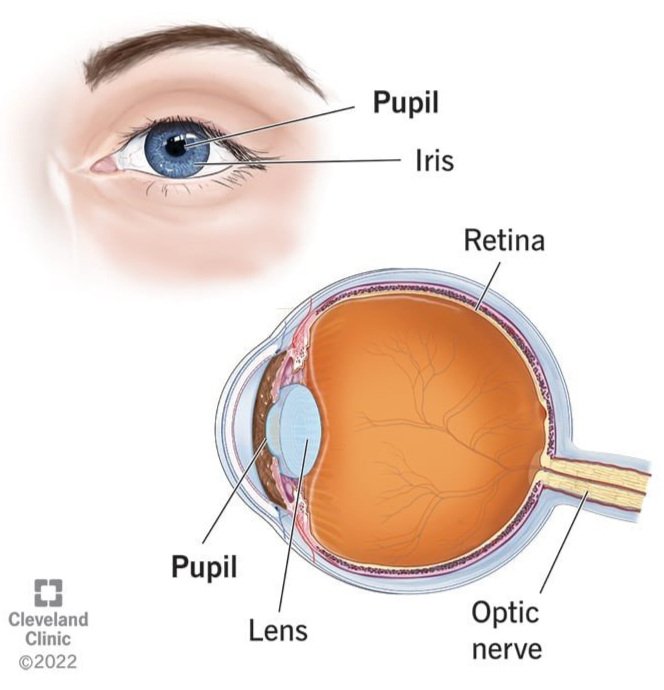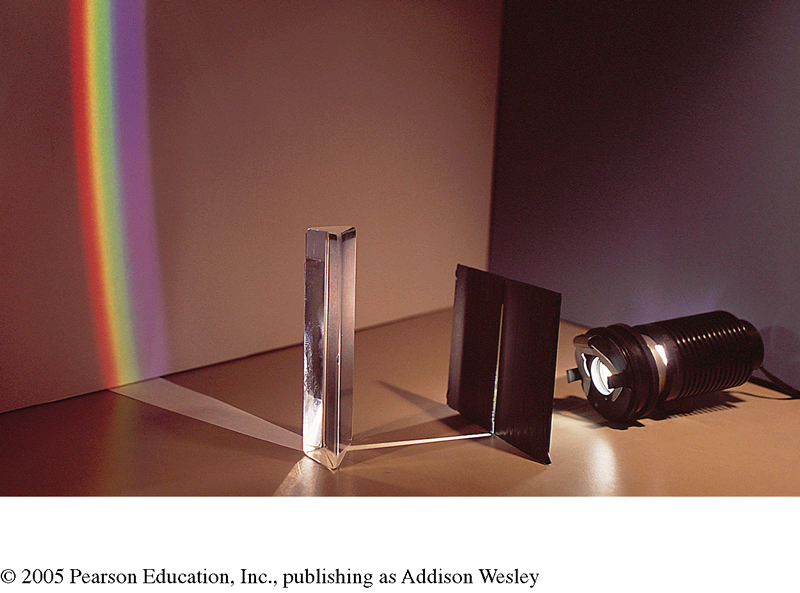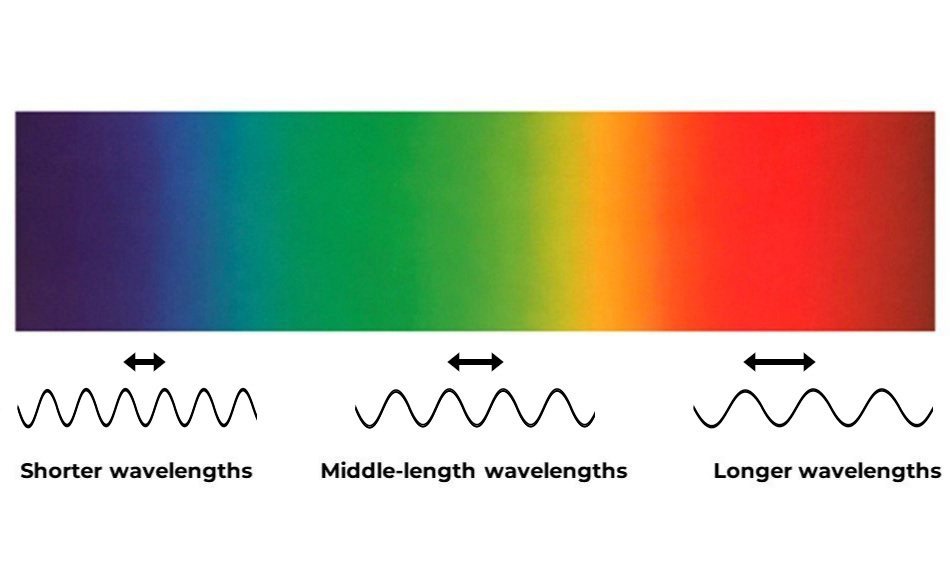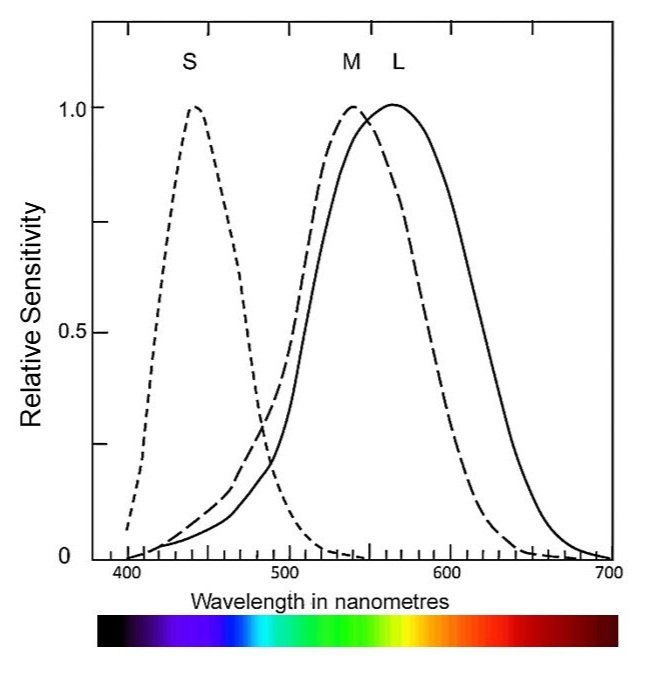So how do we see all the colours in the world?
When we look out into the world, we see many things. We see shapes, colours, whether objects are moving and how fast they are moving. All of this visual information comes to us via light. The light enters our eyes, gets detected or absorbed, and is decoded and interpreted within our visual system (which includes our eyes, brain and all their neurological connections) to give us a view of what we are looking at. The whole process is extraordinarily complex and not fully understood.
One facet of our visual system allows us to see in colour. For this we need: 1) a source of light; 2) an object that interacts with the beam of light; 3) a person – us – with eyes and a brain (see Figure 1). Light is key for us to see colour, and it activates our whole visual system. Although we may sometimes dream in colour, or remember our experiences of colour, most of our daily colour experiences begin with light. Light can either enter our eyes directly, for example when we are looking at our phones or a computer screen, or it can interact with and reflect from a surface, for example when we look at an apple, or it can transmit through transparent objects like filters or glass.
Figure 1. Everyday notion of colour vs. perceptual nature of colour. (Diagrams courtesy of Andreas Schwarz.)
Light activates our visual system
Figure 2. Parts of the eye
How does the beam of light entering our eyes initiate our colour vision? When light enters our eye through our pupil, it travels until it hits the back of our eye. The back of our eye contains the retina, which itself contains cones and rods, specialized cells designed to absorb light and send messages to other cells. The parts of the eye are shown in Figure 2.
Cones are active in high levels of illumination and rods are active in low levels of illumination. We have three types of cones, and only one type of rod. What allows us to see in colour is the fact that we have three different types of cones, and our visual system compares how much light is detected by each type of cone.
The portion of the electromagnetic spectrum which can be detected by the human eye (i.e. by our cones) is called the visible spectrum. We can see the components of the visible spectrum when white light passes through a prism (see Figure 3). Different parts of the spectrum have different wavelengths. (The wavelength is the distance from one wave peak to the next.) Figure 4 shows a visualization for the relative relationships between the short, middle-length and long wavelengths in the visible spectrum.
Figure 3. The visible spectrum produced by a beam of white light passing through a prism.
Figure 4. Relative relation of short, middle-length and long wavelengths in the visible spectrum.
Figure 5. Full 360-degree circuit of hues visible to the human eye. (Image courtesy David Briggs.)
When we see coloured objects or lights, our visual system compares how much light we receive from different parts of the spectrum. When light reflects from surfaces or travels directly from light sources to our eye, it is the balance between the different parts of the spectral composition of the light which is the starting point for seeing colours. How exactly we see those colours is the result of an ensuing complex process.
Figure 5 depicts the 360-degree hue circuit we can see, depending on the relative balance of light coming to our eyes.
How do we see coloured objects?
Figure 6. Visualization showing the relative amounts of short, middle and long wavelengths reflected by a red coloured leaf and a blue coloured jacket.
In order to see a red-coloured leaf, and identify it as red, we need 1) a source of light; 2) the leaf; and 3) us, with our eyes and brain. When the light from the Sun illuminates the leaf, it interacts with the leaf, and the leaf reflects some but not all of the sunlight to our eyes. In this case the leaf reflects light with not many short wavelengths, some middle wavelengths and many long wavelengths (see Figure 6).
When we look at a blue-coloured jacket, as it interacts with the illuminating source of light (from the Sun, or a lightbulb) it reflects some but not all of the light from the source. In this case it reflects light with many short wavelengths, some middle wavelengths and not many long wavelengths (see Figure 6).
There is a common misconception that ‘red objects appear red because they reflect only red wavelengths to our eyes’. This is not the case. Each coloured object reflects light containing all wavelengths to our eyes, but some parts of the spectrum are reflected to a greater degree than others. It is the way that our eye and brain interpret the whole distribution of wavelengths or the overall balance of light from all parts of the visible spectrum which gives rise to colour perception. Also remember that neither light rays nor their wavelengths are coloured; rather their distribution activates the perception of a particular colour by our visual system.
What do our cones do?
Figure 7. Relative responses of our three types of cones. Note that each cone type is responsive to (or can absorb light over) a wide range of wavelengths. (One nanometre is one-billionth of a metre.)
How does light’s reflected distribution of wavelengths connect to colour perception? We have three types of cones, and each type can absorb a certain range of wavelengths. One type of cone absorbs a range of short wavelengths best; another type of cone absorbs the middle-length wavelengths best; and the third type of cone absorbs a range of long wavelengths best. These three cone types are referred to as our S- (for Short), M- (for Middle) and L- (for Long) cones. These are often referred to as our ‘Blue, Green and Red’ cones, however these terms lead to the misconception that each only absorbs a narrow band of light. Rather, each can absorb a wide range of wavelengths.
Figure 7 shows the wavelength ranges that can be absorbed by each type of cone.
When light enters our eye as we look at an object, our cones absorb this light when we experience high levels of illumination, but each type of cone absorbs different amounts of light. To decode the colour of the object we are viewing, our visual system compares how much light is absorbed by each type of cone. (A remarkable feat!) It is this process of comparing the different responses by different types of cones combined with neurological processes that occur in the brain that ultimately leads to the perception of a particular colour. A common misconception is that our cones are solely responsible for our colour vision, however they only play one part in the visual process. It is the comparative process, responding to the balance of light entering our eyes, which is most important for decoding the distribution of light and hence colour. Our cones are the ‘front line’ which first absorb the light, while the rest of our visual system (which includes many cell types from our eyes to our brain) decodes the distribution of the light by comparing the signals created by the relative response rates of the different types of cones. This complex process ultimately determines the exact hue, lightness/value and chroma we perceive for every colour in our visual field.
What about our rods?
As we only have one type of rod, when we experience low levels of illumination and only our rods respond to light, there is no way for our visual system to compare how much light is coming in from different wavelength ranges. There is thus no information that can be obtained about the colour of the object, so in very low levels of illumination, we see the world in greyscale. This experience however, is very uncommon in our everyday lives, as we are generally exposed to some kind of ambient lighting. Instead, in these cases of very low levels of illumination, our capacity to see colours is highly diminished. Both rods and cones contribute to our colour vision, but colours appear to be ‘washed out’ or have very low chroma.
What is the minimum required to see in colour?
In order to see in colour, our visual system needs at least two receptors, sensitive to two different wavelength ranges of light. Most mammals, and some people with limited colour vision have dichromatic vision, with two types of cones. They therefore see in colour, but with a more limited range of colours than someone with trichromatic vision, or three types of cones. Some birds have tetrachromatic vision with four types of cones, and have increased colour discrimination capability compared to trichromats. There is ongoing research on whether a small fraction of women also have tetrachromatic vision (see link below).
Is there anything else involved in seeing colour?
This physiological description of how our visual system decodes light that enters our eye and interprets it as colour sensations is fundamental to how we see colour, but it is not the whole story. Other contextual factors like light sources, surrounding colours and the transparency and textures of objects all impact the colours we see. Our visual system readily adapts to our environment; this adaption to the levels and colours of illumination for example, impacts how we perceive colours. There are other less tangible but nonetheless important factors that also impact how we see colour: our language and cultural background, our emotional state, our experiences and memories. Colour perception is a complex, multi-layered, nuanced and dynamic process!
FIND OUT MORE:
A good overview of Colour Vision by Karen DeValois and Mike Webster.
Find out more about research on tetrachromacy at the University of Newcastle.










